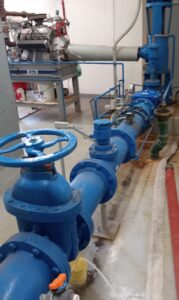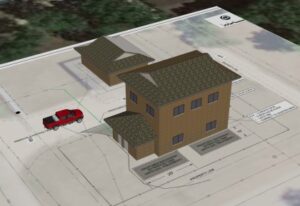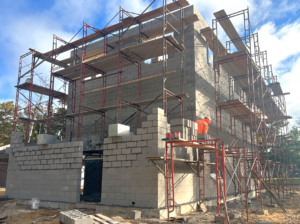The City of Adams chose to voluntarily test both of their municipal wells for per- and polyfluoroalkyl substances (PFAS) in early 2022, and after learning of concerning results, the City immediately took action. Water samples from Well No. 4 showed PFAS in excess of the Department of Health Services (DHS) Hazard Index. Within days of receiving news of the results, the DNR was consulted, City officials were notified, and Well No. 4 was taken out of service to protect the health of the community.

The City of Adams’ municipal water system dates back to 1935. It currently consists of two groundwater wells and two elevated storage tanks. The city also provides water to the neighboring Village of Friendship through three metered connections, so this project impacts a combined Adams-Friendship population of almost 2,500. Well No. 4 was constructed in 1995 — a sand and gravel well with a pumping capacity of 900 gallons per minute.
Water samples extracted from Well No. 4 have typically shown very good water quality, but recent testing detected the presence of PFAS — a category of manmade “forever chemicals” linked to a variety of adverse health effects. The most concerning test results were collected in September of 2023 when PFHXS was 59.7 parts per trillion, PFOS was 16.5 ppt, the DHS Hazard Index was 2.5, and the US EPA Hazard Index was 6.64. The current levels of PFAS in Well No. 4 do not exceed any current drinking water enforcement standards. However, the current levels would exceed the proposed PFAS enforcement standards, which are scheduled to become effective by April 2027.
With this PFAS data on hand, the City contracted with MSA to develop a feasibility study to evaluate alternatives and recommend the best path forward. The results of the study recommended water treatment at Well No. 4 to restore water supply capacity, deliver clean water to the community, and to successfully meet current and future water demand.
City leaders then proceeded to the design phase, which included rapid small-scale column testing to verify treatment effectiveness on an accelerated timeline. This testing confirmed that treatment using granular activated carbon (GAC) would be a good long-term solution for the City.

Rendering of new treatment building.
The proposed GAC adsorption system includes a new water treatment building on site at Well No. 4. The process involves water from Well No. 4 passing through two 12-foot-diameter vertical pressure vessels — operated in a series — which each contain approximately 40,000 pounds of granular activated carbon that absorb PFAS compounds. Operation of the two GAC vessels in a series will allow the effluent from the first vessel to be monitored for PFAS, and the GAC media replaced when it reaches concentration levels of regulatory concern.
The City sought funding assistance through the DNR Safe Drinking Water Loan Program (SDWLP) by applying in 2023. The PFAS treatment project at Well No. 4 had one of the highest priority ranking scores in the state and received 65% principal forgiveness/grant — the highest percentage in the state awarded for a PFAS project that year.
The project is currently under construction and is expected to be fully operational in late 2025.

Looking northeast at the building during masonry installation.
